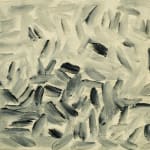

Lee Ufan
28 3/4 x 23 5/8 in
Provenance
Sale: Mainichi, December 2007
Private collection, Seoul
Literature
PUBLIC NOTES
Lee Ufan is a minimalist painter, sculptor and academic born in Haman County, South Korea. Lee Ufan’s art, who has lived and worked in Japan since 1956, is deeply rooted in modern European phenomenology combined with an Eastern appreciation of the nature of materials. As the main theorist of Mono-ha (School of Things), Japan’s first internationally recognized contemporary art movement, Lee ufan advocates a method of rejecting Western notions of representation and emphasizing materials and interrelation between space and matter; a far cry from the Eurocentic practices of 1960s postwar Japan. He has been honoured by the government of Japan for his great contribution to contemporary art in Japan.
This piece is a vivid example of the artist’s seminal “Wind” series created throughout the 1980s, recognized by free and dynamic brushstrokes filling a deeply empty space. Exemplifying what the artist described as “the living composition of empty spaces”, With Winds stirs a rhythm and lyricism that examines the spatiotemporal relationships between the viewer and components.

